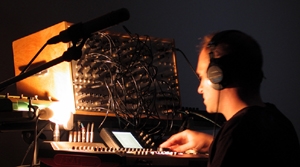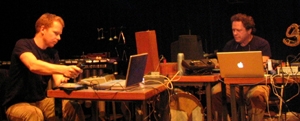Feature: Reviews
The Lab Experiments On Itself
The Board of Directors of The Lab in San Francisco has initiated an ambitious, idealistic and potentially risky reorganization of its staff structure, physical plant and curatorial direction.
On May 16th, in a move that some perceived as sudden but that had in fact been germinating for months, the Board’s Personnel & Finance Committee [P&FC] put forth a proposal* to revamp the organization’s management structure, replacing the Executive Director position with what was initially described as three equal Co-Director positions to be filled by former Board Secretary Alex Burke, intern Sherrie Koyama and current Associate Director Kristen Chappa.
At the Board’s next meeting, on June 7th, this was amended slightly; Alex Burke will now hold the title of Interim Managing Director, to more accurately reflect the Board’s interim organizational intentions. Lab staff and the other co-directors will report to Mr. Burke. This structure will be in place at least through August 30, 2005.
Co-founder and current Board President Alan Millar explained that The Lab is doing a complete organizational review and plans on publishing a three-year “planning outcomes document” after September 30th, 2005.
The key issues generating the current and future changes are partly financial but primarily conceptual, and point to the Board’s desire for more control over both administrative and curatorial processes. The proposed changes are designed to correct what the Board felt was a curatorial and organizational drifting-away from The Lab’s long-standing mission of serving emerging artists.
Some of the proposals being developed over the summer include a less hierarchical staff structure, stronger focus on new media technologies, and reconfiguration of the physical plant.
The new co-director schema could be just the first step towards a more experimental, flexible, co-op style management structure in which co-directors would rotate jobs every year or so and hold tenure for only a few years. Combined with an emphasis on skills training through professional workshops, The Lab seems to be striving towards becoming a laboratory for development of emerging administrators as well as artists.
New media technologies would be stressed administratively as well as curatorially. A planned new Web site due to launch at the end of the summer would feature blogging and artist-managed mini-sites featuring archival content. E-mail and e-news technologies will carry the marketing load and the familiar bi-monthly printed calendar will be discontinued.
Possible changes to the physical space of the gallery could include construction of a black box theater and a dedicated media gallery. These and other proposed reconfigurations of exhibition spaces would be designed to increase the number of emerging artists who could be presented annually.
Not all of The Lab’s board members and long-term supporters are in favor of the changes. Long-time board member Richard Pinegar resigned after the May 16th vote because, as he told me later, “I felt that by letting such a skilled, trusted and experienced administrative director go, this board was showing that they were out of touch with the reality of fundraising in this town.”
Millar said that he will personally visit all major funders in order to explain the administrative changes, adding that he has “high hopes that the artists, community, funders and press will take a bit of a wait and see attitude, and let us prove to them that these changes are going to lead to a more dynamic organization with a higher capacity for positive change.”
A wait and see attitude may in fact be the only viable option, as the risks involved are as substantial as the goals are idealistic. In any organization, the process of institutionalization can lead not only to stability but also to stagnation. Focus can sometimes narrow onto serving the needs and survival of the institution rather than serving the original client base. A purposeful de-institutionalization process is a potentially bold maneuver, both symbolically and functionally, but lots of questions arise.
Will The Lab’s funders stay the course? Will new funders be found? Will a new non-hierarchical and possibly experimental management structure re-energize programming or create chaos? Will the Board be able to maintain its current level of engagement in the face of the many challenges facing it? Will the Board’s hands-on approach mesh with the new management structure?
Will the decades of institutional memory lost in the departures of long-term administrators and disaffected supporters be replaced by increased support from a revitalized and potentially expanded community?
And, finally, will refocusing on its mission to support emerging artists serve The Lab and the community at large? Over the past twenty years The Lab has developed a national (and to some degree international) reputation while still remaining relatively accessible to emerging and mid-career local artists. Does it make sense to risk that credibility in order to create more first-time exhibition opportunities for younger artists when there are already so many artist-run storefront art spaces doing just that?
Only time will tell. San Francisco’s current cultural landscape has been positively affected and inspired by The Lab’s activities during the last two decades. The current reorganization-in-progress may have an equally powerful and positive effect during the next two decades.
As Millar puts it, “The LAB is changing. Try to keep up.”
###
*Proposals made by the P&FC are automatically accepted unless a subsequent motion to override carries by a 75% margin. The small size of the Lab’s current board mathematically assures that P&FC proposals can’t be overridden unless someone on the P&FC changes their vote.




Scott, thanks for your thoughtful and well-written article. One has to wonder if the current shift will lead to the loss of funding and support from art-lovers and arts foundations and the need for more corporate types of funding. And if so, will this result in a danger of a more “corporate” leaning in the work that is nurtured there. Will the work continue to be truly experimental, or will we see a rise in the kind of art that often passes as “cutting edge” because of it’s use of new technology but is is sometimes indistinguishable from pseudo-underground-inflected commercial art.
Another fear is for the loss of open space for work, should the physical reconfiguration involve cutting the space up into small galleries and a black-box theatre. And, in the face of difficult financial times, will the black box theatre be used for local, experimental performances, or will it go the way of Theater Artaud, and become primarily a rental house for whichever companies have the money to cover the rent.
I, for one, am saddened by the recent personnel changes there. But, I care deeply for The LAB, and I truly hope that my fears are unfounded and that something good will blossom there.
Pamela Z • June 22, 2005